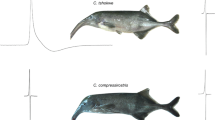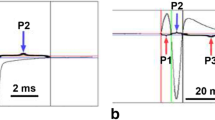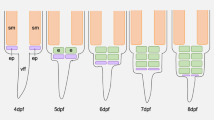Abstract
The electric organ (EO) of weakly electric mormyrids consists of flat, disk-shaped electrocytes with distinct anterior and posterior faces. There are multiple species-characteristic patterns in the geometry of the electrocytes and their innervation. To further correlate electric organ discharge (EOD) with EO anatomy, we examined four species of the mormyrid genus Campylomormyrus possessing clearly distinct EODs. In C. compressirostris, C. numenius, and C. tshokwe, all of which display biphasic EODs, the posterior face of the electrocytes forms evaginations merging to a stalk system receiving the innervation. In C. tamandua that emits a triphasic EOD, the small stalks of the electrocyte penetrate the electrocyte anteriorly before merging on the anterior side to receive the innervation. Additional differences in electrocyte anatomy among the former three species with the same EO geometry could be associated with further characteristics of their EODs. Furthermore, in C. numenius, ontogenetic changes in EO anatomy correlate with profound changes in the EOD. In the juvenile the anterior face of the electrocyte is smooth, whereas in the adult it exhibits pronounced surface foldings. This anatomical difference, together with disparities in the degree of stalk furcation, probably contributes to the about 12 times longer EOD in the adult.













Similar content being viewed by others
References
Alves-Gomes JA, Hopkins CD (1997) Molecular insights into the phylogeny of Mormyriform fishes and the evolution of their electric organs. Brain Behav Evol 49:324–350. doi:10.1159/000113223
Bass AH (1986) Species differences in electric organs of mormyrids: substrates for species-typical electric organ discharge waveforms. J Comp Neurol 244:313–330. doi:10.1002/cne.902440305
Bass AH, Hopkins C (1985) Hormonal control of sex differences in the electric organ discharge (EOD) of mormyrid fishes. J Comp Physiol A 156:587–604. doi:10.1007/BF00619109
Bass AH, Denizot JP, Marchaterre MA (1986) Ultrastructural features and hormone-dependent sex differences of mormyrid electric organs. J Comp Neurol 254:511–528. doi:10.1002/cne.902540405
Bell CC, Bradbury J, Russell CJ (1976) The electric organ of a mormyrid as a current and voltage source. J Comp Physiol 110:65–88. doi:10.1007/BF00656782
Bell CC, Libouban S, Szabo T (1983) Pathways of the electric organ discharge command and its corollary discharges in mormyrid fish. J Comp Neurol 216:327–338. doi:10.1002/cne.902160309
Bennett MVL (1970) Comparative physiology: electric organs. Ann Rev Physiol 32:471–528. doi:10.1146/annurev.ph.32.030170.002351
Bennett MVL (1971) Electric organs. In: Hoar WS, Randall DJ (eds) Fish physiology vol. V—sensory systems and electric organs. Academic Press, New York, London, pp 347–491. doi:10.1016/S1546-5098(08)60051-5
Bennett MVL, Grundfest H (1961) Studies on the morphology and electrophysiology of electric organs. III. Electrophysiology of electric organs in mormyrids. In: Chagas C, Paes de Carvalho A (eds) Bioelectrogenesis. Elsevier, London, New York, pp 113-135
Bruns V (1971) Elektrisches organ von Gnathonemus (Mormyridae) Elektrische Platte und Innervation. Zeitung für Zellforsch 122:538–563. doi:10.1007/BF00936087
Caputi AA, Carlson BA, Macadar O (2005) Electric organs and their control. In: Bullock TH, Hopkins CD, Popper AN, Fay RR (eds) Electroreception. Springer, New York, pp 420–424. doi:10.1007/0-387-28275-0_14
Carlson BA (2002) Electric signaling behavior and the mechanisms of electric organ discharge production in mormyrid fish. J Physiol Paris 96:405–419. doi:10.1016/S0928-4257(03)00019-6
Cheng C (2012) Morphological correlates of signal variation in weakly electric mormyrid fish. Honors Thesis, Cornell University
Denizot JP, Kirschbaum F, Westby GWM, Tsuji S (1982) On the development of the adult electric organ in the mormyrid fish Pollimyrus isidori (with special focus on the innervation). J Neurocyt 11:913–934. doi:10.1007/BF01148308
Feulner PGD, Kirschbaum F, Tiedemann R (2008) Adaptive radiation in the Congo River: an ecological speciation scenario for African weakly electric fish (Teleostei; Mormyridae; Campylomormyrus). J Physiol 102:340–346. doi:10.1016/j.jphysparis.2008.10.002
Few W, Zakon H (2007) Sex differences in and hormonal regulation of Kv1 potassium channel gene expression in the electric organ: molecular control of a social signal. Dev Neurobiol 67:535–549. doi:10.1002/dneu.20305
Freedman EG, Olyarchuk J, Marchaterre MA, Bass AH (1989) A temporal analysis of testosterone-induced changes in electric organs and electric organ discharges of mormyrid fishes. J Neurobiol 20:619–634. doi:10.1002/neu.480200703
Friedman MA, Hopkins CD (1996) Tracking individual mormyrid electric fish in the field using electric organ discharge waveforms. Anim Behav 51:391–407. doi:10.1006/anbe.1996.0037
Gallant JR, Arnegard ME, Sullivan JP et al (2011) Signal variation and its morphological correlates in Paramormyrops kingsleyae provide insight into the evolution of electrogenic signal diversity in mormyrid electric fish. J Comp Physiol A 197:799–817. doi:10.1007/s00359-011-0643-8
Gallant JR, Hopkins CD, Deitcher DL (2012) Differential expression of genes and proteins between electric organ and skeletal muscle in the mormyrid electric fish Brienomyrus brachyistius. J Exp Biol 215:2479–2494. doi:10.1242/jeb.063222
Grant K, Bell CC, Clausse S, Ravaille M (1986) Morphology and physiology of the brainstem nuclei controlling the electric organ discharge in mormyrid fish. J Comp Neurol 245:514–530. doi:10.1002/cne.902450407
Grier JH (1981) Cellular organization of the testis and spermatogenesis in fishes. Am Zool 21:345–357. doi:10.1093/icb/21.2.345
Hopkins CD (1980) Evolution of electric communication channels of mormyrids. Behav Ecol Sociobiol 7:1–13. doi:10.1007/BF00302513
Hopkins CD (1981) On the diversity of electric signals in a community of mormyrid electric fish in West Africa. Am Zool 21:211–222. doi:10.1093/icb/21.1.211
Hopkins CD (1999) Design features for electric communication. J Exp Biol 202:1217–1228
Hopkins CD, Bass AH (1981) Temporal coding of species recognition signals in an electric fish. Science 212:85–87. doi:10.1126/science.7209524
Kirschbaum F (1977) Electric-organ ontogeny—distinct larval organ precedes adult organ in weakly electric fish. Naturwissenschaften 64:387–388. doi:10.1007/BF00368748
Kirschbaum F (1982) Die Entwicklung des “adulten” elektrischen Organes bei Pollimyrus isidori (Mormyridae, Teleostei). Verh Dtsch Zool Ges 75:242
Kramer B (1996) Electroreception and communication in fishes. Gustav Fischer, Stuttgart, pp 44–73
Kramer B, Kuhn B (1994) Species recognition by the sequence of discharge intervals in weakly electric fishes of the genus Campylomormyrus (Mormyridae, Teleostei). Anim Behav 48:435–445. doi:10.1006/anbe.1994.1257
Landsman RE (1993) Sex-differences in external morphology and electric organ discharges in imported Gnathonemus petersii (Mormyriformes). Anim Behav 46:417–429. doi:10.1006/anbe.1993.1211
Lissmann HW (1958) On the function and evolution of electric organs in fish. J Exp Biol 35:156–191
Marcusen J (1864) Die Familie der Mormyren. Eine anatomisch-zoologische Abhandlung. Eggers et Comp, St Petersburg, pp 89–104
McAnelly ML, Zakon HH (2000) Coregulation of voltage-dependent kinetics of Na+ and K+ currents in electric organ. J Neurosci 20:3408–3414
Moller P (1970) “Communication” in weakly electric fish, Gnathonemus niger (Mormyridae) I. Variation of electric organ discharge (EOD) frequency elicited by controlled electric stimuli. Anim Behav 18:768–786. doi:10.1016/0003-3472(70)90026-6
Mulisch M, Welsch U (2010) Romeis-Mikroskopische Technik, 18th edn. Spektrum, Heidelberg
Ogneff J (1898) Einige Bemerkungen über den Bau des schwachen elektrischen Organs bei den Mormyriden. Zeitschrift für wissenschaftliche Zool 64:565–595
Rohlf FJ (2013) TpsDig, Version 2.17, Department of Ecology and Evolution, State University of New York at Stony Brook. Stony Brook
Rüppel E (1832) Fortsetzung der Beschreibung und Abbildung mehrerer neuen Fische im Nil entdeckt. Frankfurt a.M
Schlichter H (1906) Über den feineren Bau des schwach elektrischen Organs von Mormyrus oxyrhinchus. Zeitschrift für wissenschaftliche Zool 84:479–525
Schugardt C, Kirschbaum F (2002) Nilhechte des “Formenkreises” Campylomormyrus numenius: Bemerkungen zur Ontogenese des Habitus, der elektrischen Entladung sowie zum Fortpflanzungsverhalten. In: Greven H, Riehl R (eds) Verhalten von Aquarienfischen II. Birgit Schmettkamp Verlag, Bornheim, pp 137–146
Schwartz IR, Pappas GD, Bennett MV (1975) The fine structure of electrocytes in weakly electric teleosts. J Neurocytol 4:87–114. doi:10.1007/BF01099098
Sullivan JP, Lavoué S, Hopkins CD (2000) Molecular systematics of the African electric fishes (Mormyroidea: Teleostei) and a model for the evolution of their electric organs. J Exp Biol 203:665–683
Szabo T (1956) Sur la structure et le type d’innervation de l’électroplaque d’un Mormyre. C R Acad Sci 242:2045–2048
Szabo T (1957) Le muscle d’origine de l’organe electrique d’un Mormyre. Zeitschrift für Zellforsch und Mikroskopische Anat 47:77–79. doi:10.1007/BF00340005
Szabo T (1958) Structure intime de l’organe electrique de trois Mormyrides. Zeitschrift für Zellforsch 40:33–45. doi:10.1007/BF00335061
Szabo T (1960) Development of the electric organ of Mormyridae. Nature 188:760–762. doi:10.1038/188760b0
Szabo T (1961) Rapports onto génétique s entre l’organe électrique, son innervation et sa commande encéphalique (Mormyrus rume). Zeitschrift für Zellforsch und Mikroskopische Anat 55:200–203. doi:10.1007/BF00340930
Taverne L (1972) Ostéologie des genres Mormyrus Linné, Mormyrops Müller, Hyperopisus Gill, Isichthys Gill, Myomyrus Boulenger, Stomatorhinus Boulenger et Gymnarchus Cuvier considérations générales sur la systématique des poissons de l`ordre des Mormyriformes. MRAC, Tervuren
Trzcinski N, Hopkins CD (2008) Electric signaling and electroreception properties in electric fishes of the genus, Campylomormyrus Mormyridae. Cornell Synap 2:19–22
Von der Emde G (1999) Active electrolocation of objects in weakly electric fish. J Exp Biol 202:1205–1215
Von Der Emde G (2006) Non-visual environmental imaging and object detection through active electrolocation in weakly electric fish. J Comp Physiol A 192:601–612. doi:10.1007/s00359-006-0096-7
Von der Emde G, Bleckmann H (1998) Finding food: senses involved in foraging for insect larvae in the electric fish Gnathonemus petersii. J Exp Biol 201:969–980
Von der Emde G, Ringer T (1992) Electrolocation of capacitive objects in four species of pulse-type weakly electric fish I. Discrim Perform Ethol 91:326–338. doi:10.1111/j.1439-0310.1992.tb00873.x
Von der Emde G, Schwarz S (2002) Imaging of objects through active electrolocation in Gnathonemus petersii. J Physiol Paris 96:431–444. doi:10.1016/S0928-4257(03)00021-4
Wallace RA, Selman K (1981) Cellular and dynamic aspects of oocyte growth in teleosts. Am Zool 21:325–334. doi:10.1093/icb/21.2.325
Westby GWM, Kirschbaum F (1982) Sex differences in the waveform of the pulse-type electric fish, Pollimyrus isidori (Mormyridae). J Comp Physiol 145:399–403. doi:10.1007/BF00619344
Zakon HH, Lu Y, Zwickl DJ, Hillis DM (2006) Sodium channel genes and the evolution of diversity in communication signals of electric fishes: convergent molecular evolution. PNAS 103:3675–3680. doi:10.1073/pnas.0600160103
Acknowledgments
We thank S. Abelt, H. Höft and D. Bernau for technical assistance. Financial support is acknowledged from the University of Potsdam and the Leibniz-SAW project GENART. Further, financial support is acknowledged from Deutsche Forschungsgemeinschaft (TI 349/1-1 and TI 349/1-2).
Ethical approval
All applicable international, national and/or institutional guidelines for the care and use of animals were followed.
Author information
Authors and Affiliations
Corresponding author
Electronic supplementary material
Below is the link to the electronic supplementary material.
359_2015_995_MOESM1_ESM.xlsx
Online Resource 1: five EOD characteristics for 82 specimens of four Campylomormyrus species (C. compressirostris, C. numenius, C. tamandua and C. tshokwe) measured via a custom-made MATLAB script (XLSX 16 kb)
Rights and permissions
About this article
Cite this article
Paul, C., Mamonekene, V., Vater, M. et al. Comparative histology of the adult electric organ among four species of the genus Campylomormyrus (Teleostei: Mormyridae). J Comp Physiol A 201, 357–374 (2015). https://doi.org/10.1007/s00359-015-0995-6
Received:
Revised:
Accepted:
Published:
Issue Date:
DOI: https://doi.org/10.1007/s00359-015-0995-6




